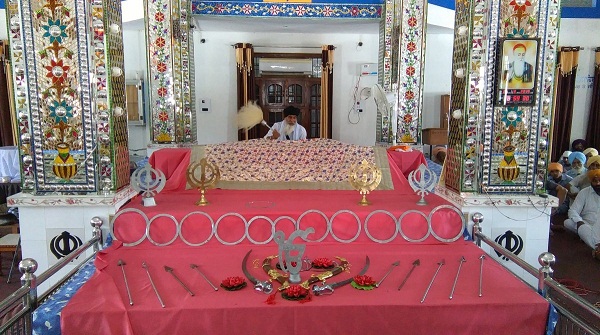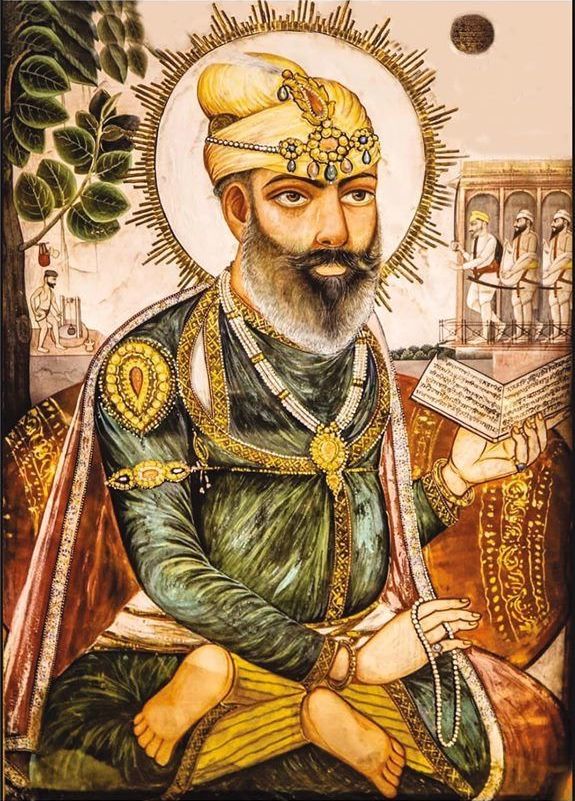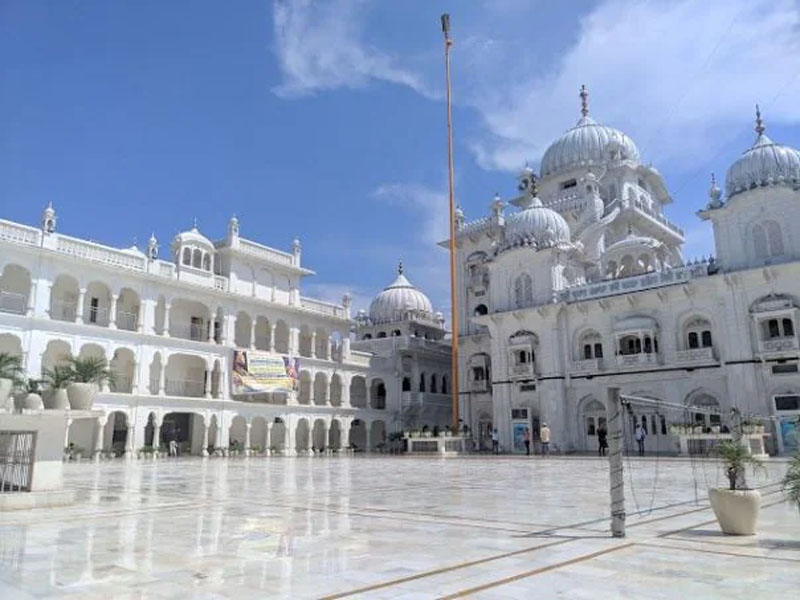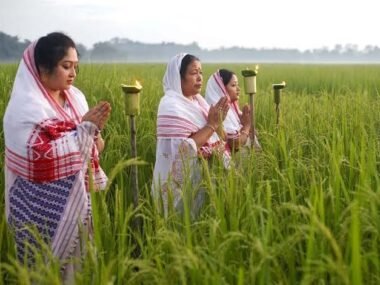Introduction

Gurdwara Sri Guru Tegh Bahadur Sahib is a revered Sikh shrine located in Dhubri town, situated on the banks of the mighty Brahmaputra River in Assam, India. This gurdwara holds immense historical and religious significance for Sikhs and followers of other faiths alike. It is not only a place of worship but also a symbol of communal harmony and devotion.
Historical Significance
The history of this sacred gurdwara dates back to the early 16th century when Guru Nanak Dev, the first Sikh Guru, visited Assam. In 1505 AD, during his journey from Dhaka to Assam, Guru Nanak Dev met Srimanta Sankardeva, the great Vaishnavite saint and social reformer of Assam. This meeting is considered a landmark event in spiritual history, symbolizing an exchange of ideas and religious philosophies between Sikhism and the Bhakti movement of Assam.
More than a century later, in the 17th century, the ninth Sikh Guru, Guru Tegh Bahadur, visited this region. Recognizing the spiritual importance of the place, he established the gurdwara, which later became a center of Sikh religious activities in Assam. His presence and teachings played a significant role in spreading Sikh ideals in the northeastern region of India.
Architectural Beauty and Structure
The gurdwara is an architectural marvel, reflecting the simplicity and grace of Sikh religious structures. Surrounded by lush greenery and located by the banks of the Brahmaputra, the serene environment of the gurdwara offers a peaceful retreat for devotees. The gurdwara complex consists of the main prayer hall, where the Guru Granth Sahib (the holy scripture of Sikhism) is placed, and other facilities for devotees and visitors.
The Annual Martyrdom Festival (Sahidee-Guru-Parav)

Every year in December, the gurdwara hosts a grand festival to commemorate the martyrdom of Guru Tegh Bahadur. More than 50,000 devotees from various religious backgrounds, including Hindus, Sikhs, and Muslims, visit the shrine to pay homage to the revered Guru. This festival, known as Sahidee-Guru-Parav, is observed with immense devotion and reverence.
Festival Schedule and Celebrations
The festival begins on the 3rd of December with great solemnity and grandeur. Devotees gather in large numbers, participating in prayers, kirtans (devotional singing), langar (community meal), and other religious activities. The celebrations include:
- Akhand Path: A continuous, non-stop recitation of the Guru Granth Sahib, lasting for 48 hours.
- Kirtan and Katha: Devotional singing and storytelling sessions that narrate the life and sacrifices of Guru Tegh Bahadur.
- Nagar Kirtan: A grand procession where devotees carry the Guru Granth Sahib while chanting hymns and spreading messages of peace and harmony.
- Langar Seva: Free community meals served to all visitors, emphasizing the Sikh principle of selfless service and equality.
The festival is not only a religious gathering but also a reflection of India’s rich cultural and spiritual diversity, as people from different faiths unite in reverence for Guru Tegh Bahadur.
Guru Tegh Bahadur: The Martyr for Religious Freedom
Guru Tegh Bahadur is often referred to as the “Hind Di Chadar” (Protector of Hindus) due to his selfless sacrifice for religious freedom. He stood against the forced conversions imposed by the Mughal Emperor Aurangzeb and defended the rights of Hindus and other non-Muslims to practice their faith freely. His ultimate martyrdom in 1675 in Delhi is regarded as a pivotal moment in Indian history, marking the triumph of religious tolerance and righteousness.
Communal Harmony and the Gurdwara’s Role
One of the most remarkable aspects of Gurdwara Sri Guru Tegh Bahadur Sahib is its role in promoting interfaith harmony. People from all walks of life, regardless of caste, creed, or religion, visit the shrine to seek blessings and participate in the community services offered by the gurdwara. It serves as a symbol of unity, reflecting the core teachings of Sikhism that advocate equality, compassion, and service to humanity.
How to Reach Gurdwara Sri Guru Tegh Bahadur Sahib
Dhubri, located in western Assam, is well-connected to major cities via road, rail, and air transport.
- By Air: The nearest airport is Lokpriya Gopinath Bordoloi International Airport in Guwahati, about 280 km from Dhubri.
- By Rail: Dhubri Railway Station is the nearest railway station, with connectivity to major cities.
- By Road: Regular bus and taxi services are available from Guwahati and other parts of Assam.
Conclusion
Gurdwara Sri Guru Tegh Bahadur Sahib in Dhubri is not just a religious site but a beacon of peace, spirituality, and communal harmony. Its historical connections with Guru Nanak Dev and Guru Tegh Bahadur, combined with its role in fostering unity among diverse communities, make it a significant landmark in Assam. The annual martyrdom festival draws thousands of devotees, celebrating the Guru’s legacy and teachings. Visiting this gurdwara is a spiritually enriching experience that offers a deep insight into Sikh traditions and the universal values of humanity and service.
FAQ’s
Q. What is Gurdwara Sri Guru Tegh Bahadur Sahib?
Gurdwara Sri Guru Tegh Bahadur Sahib is a Sikh temple located in Dhubri, Assam, dedicated to Guru Tegh Bahadur, the ninth Sikh Guru, and serves as a place of worship, reflection, and community service.
Q. What is the historical significance of Gurdwara Sri Guru Tegh Bahadur Sahib?
This gurdwara commemorates the visit of Guru Tegh Bahadur to Assam in the 17th century. It plays a key role in spreading Sikhism in northeastern India and represents the Guru’s efforts for religious freedom.
Q. When is the Annual Martyrdom Festival (Sahidee-Guru-Parav) held at the gurdwara?
The festival is celebrated in December each year, marking the martyrdom of Guru Tegh Bahadur, and attracts thousands of devotees for prayers, kirtans, and community service.
Q. How can I reach Gurdwara Sri Guru Tegh Bahadur Sahib?
The gurdwara is accessible via road, rail, and air. The nearest airport is in Guwahati, approximately 280 km away, while Dhubri Railway Station connects to major cities.
Q. What are the main activities during the Sahidee-Guru-Parav festival?
The festival includes Akhand Path (continuous recitation of the Guru Granth Sahib), kirtan, Nagar Kirtan (processions), and langar (community meals) served to all visitors.












